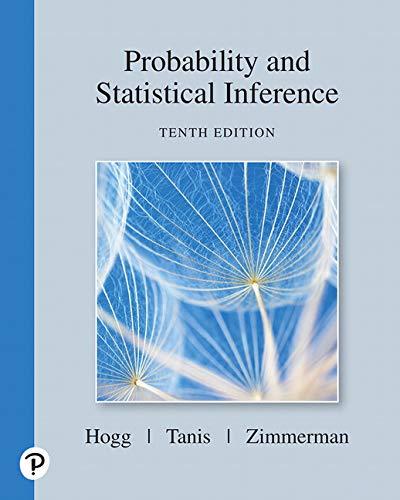
Let the joint pmf of X and Y be defined by
(a) Find
(b) Find
(c) Find
(d) Find
(c) Find
(f) Find
(g) Are X and Y independent or dependent? Why or why not?
(h) Find the
Want to see the full answer?
Check out a sample textbook solution
Chapter 4 Solutions
Probability And Statistical Inference (10th Edition)
- Could you explain how to do part (c) pleasearrow_forwardLet X have a uniform distribution on (0,2) and let Y be independent of X with a uniform distribution over (0,3). Determine the cumulative distribution function of S=X+Y. Please can you help me solve this question. Also, could you explain how you know at which intervals to split up the cases of the fucntion.arrow_forwardCould you please solve this question by sketching a graph to find the region of integration and the bounds of the integralarrow_forward
- Please could you provide a step by step solutions to this question and explain every step.arrow_forwardCould you please help me with question 2bii. If possible could you explain how you found the bounds of the integral by using a graph of the region of integration. Thanksarrow_forwardCould you explain how the inequalities u in (0,1), we have 0 ≤ X ≤u-Y for any 0 ≤Y<u and u in (1,2), we either have 0 ≤ X ≤u-Y for any u - 1 < Y<1, or 0≤x≤1 for any 0 ≤Y≤u - 1 are obtained please. They're in the solutions but don't understand how they were derived.arrow_forward
- Can you please explain how to find the bounds of the integrals for X and Y and also explain how to find the inequalites that satisfy X and Y. I've looked at the solutions but its not clear to me on how the inequalities and bounds of the integral were obtained. If possible could you explain how to find the bounds of the integrals by sketching a graph with the region of integration. Thanksarrow_forwardQUESTION 18 - 1 POINT Jessie is playing a dice game and bets $9 on her first roll. If a 10, 7, or 4 is rolled, she wins $9. This happens with a probability of . If an 8 or 2 is rolled, she loses her $9. This has a probability of J. If any other number is rolled, she does not win or lose, and the game continues. Find the expected value for Jessie on her first roll. Round to the nearest cent if necessary. Do not round until the final calculation. Provide your answer below:arrow_forward5 of 5 (i) Let a discrete sample space be given by Ω = {ω1, 2, 3, 4}, Total marks 12 and let a probability measure P on be given by P(w1) 0.2, P(w2) = 0.2, P(w3) = 0.5, P(w4) = 0.1. = Consider the random variables X1, X2 → R defined by X₁(w3) = 1, X₁(4) = 1, X₁(w₁) = 1, X₁(w2) = 2, X2(w1) = 2, X2(w2) = 2, X2(W3) = 1, X2(w4) = 2. Find the joint distribution of X1, X2. (ii) [4 Marks] Let Y, Z be random variables on a probability space (N, F, P). Let the random vector (Y, Z) take on values in the set [0,1] × [0,2] and let the joint distribution of Y, Z on [0,1] × [0,2] be given by 1 dPy,z(y, z) (y²z + y²²) dy dz. Find the distribution Py of the random variable Y. [8 Marks]arrow_forward
- Total marks 16 5. Let (,,P) be a probability space and let X : → R be a random variable whose probability density function is given by f(x) = }}|x|e¯|×| for x Є R. (i) (ii) Find the characteristic function of the random variable X. [8 Marks] Using the result of (i), calculate the first two moments of the random variable X, i.e., E(X") for n = 1, 2. (iii) What is the variance of X? [6 Marks] [2 Marks]arrow_forwardTotal marks 16 5. Let (N,F,P) be a probability space and let X : N → R be a random variable such that the probability density function is given by f(x)=ex for x € R. (i) Find the characteristic function of the random variable X. [8 Marks] (ii) Using the result of (i), calculate the first two moments of the random variable X, i.e., E(X") for n = 1,2. (iii) What is the variance of X. [6 Marks] [2 Marks]arrow_forward6. Let P be the standard normal distribution, i.e., P is the proba- bility measure on (R, B(R)) given by 1 dP(x) = 를 = e dx. √2πT Consider the random variables 21 fn(x) = (1 + x²) en+2, x Є R, n Є N. Using the dominated convergence theorem, prove that the limit Total marks 9 exists and find it. lim E(fn) n∞ [9 Marks]arrow_forward
- Algebra & Trigonometry with Analytic GeometryAlgebraISBN:9781133382119Author:SwokowskiPublisher:Cengage
 Trigonometry (MindTap Course List)TrigonometryISBN:9781337278461Author:Ron LarsonPublisher:Cengage Learning
Trigonometry (MindTap Course List)TrigonometryISBN:9781337278461Author:Ron LarsonPublisher:Cengage Learning Algebra and Trigonometry (MindTap Course List)AlgebraISBN:9781305071742Author:James Stewart, Lothar Redlin, Saleem WatsonPublisher:Cengage Learning
Algebra and Trigonometry (MindTap Course List)AlgebraISBN:9781305071742Author:James Stewart, Lothar Redlin, Saleem WatsonPublisher:Cengage Learning 

 College Algebra (MindTap Course List)AlgebraISBN:9781305652231Author:R. David Gustafson, Jeff HughesPublisher:Cengage Learning
College Algebra (MindTap Course List)AlgebraISBN:9781305652231Author:R. David Gustafson, Jeff HughesPublisher:Cengage Learning





